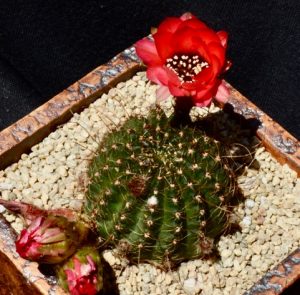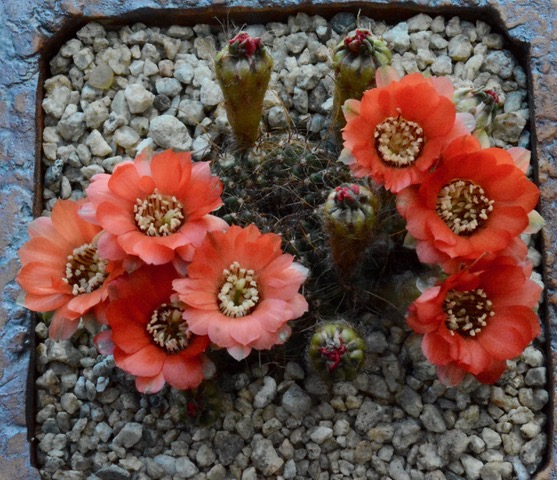Members were given one of these at the start of the year. We are to look after it and bring it back at the December 2020 meeting (the annual Pot Luck) for comparison. We are also asked to fill in the questionnaire and return it by the end of the year.
Lobivia saltensis = Echinopsis saltensis
Accepted Scientific Name: Echinopsis saltensis Speg.
Anales Mus. Nac. Buenos Aires ser. 3, 4: 487. 1905
Small but variable cactus from the Salta and Tucumán provinces of Argentina.
Shiny red flowers starting in Spring sometimes continuing into Summer.
Deep tap root and small spines that are somewhat whiskery.
Taxonomy:
GENUS: Lobivia [low-BIV-ee-uh] Anagram of Bolivia.
= Echinopsis [ek-in-OP-sis] From the Greek echinos (sea urchin or hedgehog) and opsis (like), referring to the plant’s resemblance to sea urchins
SPECIES: saltensis [sal-TEN-sis] Of or from Salta, a province in northern Argentina.
Lobivia saltensis Syn: Echinopsis saltensis is a very interesting but variable species with several forms and variety.
Origin: It has wide range and is locally common in Argentina
Habit: It is a small cactus, usually solitary, or heavily clustering.
Flowers: Pretty, shining, small up to 5 cm long, unscented, somewhat bell-shaped-bulgy, dark orange-red or crimson that appears almost black when starting to open. The stamen’s filaments are dark red and bear cream-white contrasting anthers. The stigma lobes are greenish.
Blooming season: The greater part of flowers appears in spring in the first flowering, but the plant can erratically produce some flowers in summer too.
Cultivation and Propagation: This is a much decorative frost hardy cactus easily found in cultivation. It is a summer grower species that offers no cultivation difficulties.
Water: In summer, during the vegetative period, it must be regularly watered, but allowing the substratum to completely dry up before irrigating again (but do not overwater); in winter, it’s to be kept dry. Preferable not to water on overcast days, humid days or cold winter days.
Hardiness: It is a quite frost resistant cactus, hardy to -5° C (- 10° C if very dry)
Exposure: Outside full sun or afternoon shade, inside needs bright light, and some direct sun, but, as a former mountain dweller, does not care for extremely high temperatures in summer.
Links to sources of information:
Also see the SCCSS Annual Plant List

